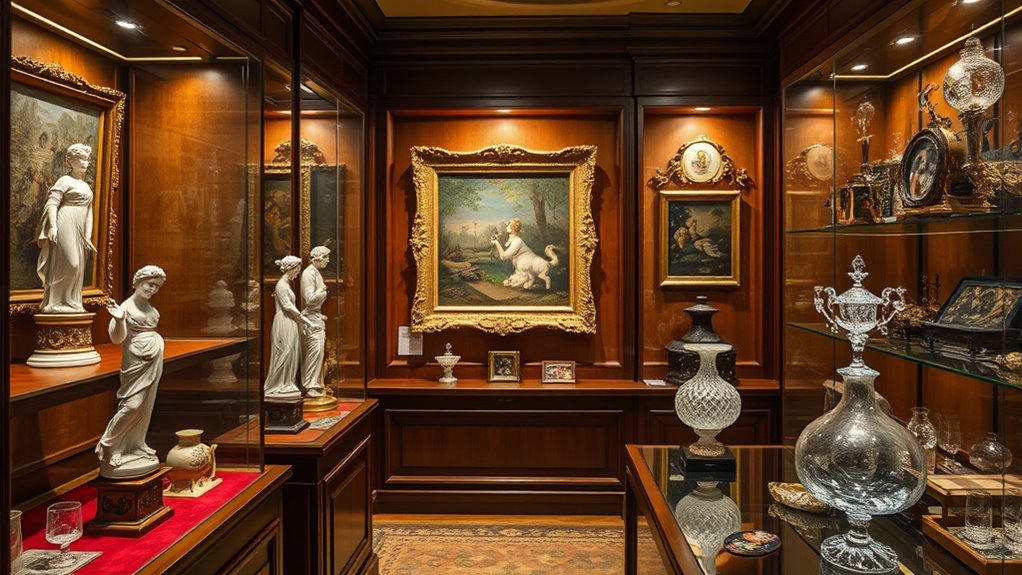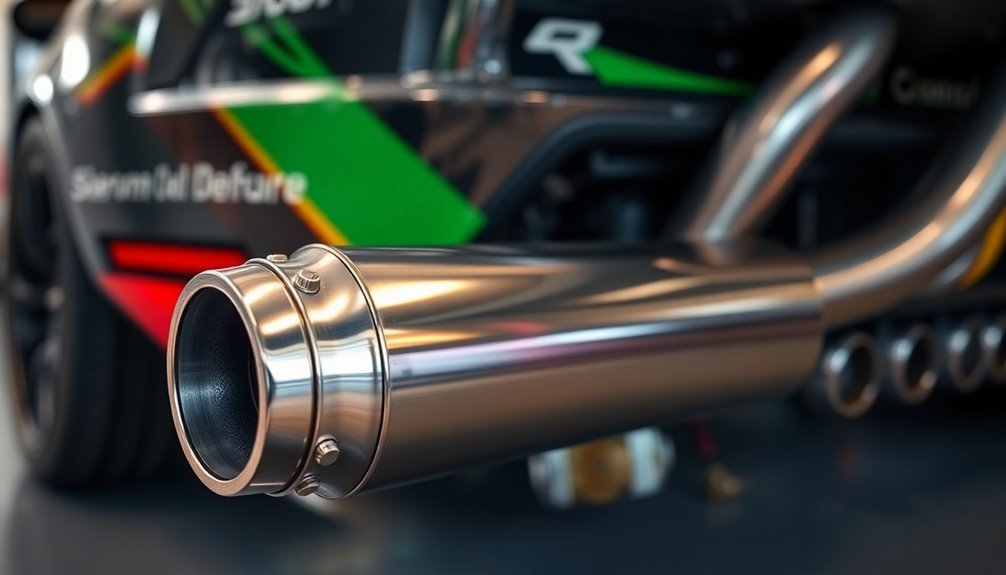Collecting rare art is a luxurious hobby that combines passion with the potential for significant financial growth. When you acquire unique, valuable pieces, you enjoy exclusivity, cultural storytelling, and prestige. Building a smart collection involves understanding market trends, verifying provenance, and diversifying across artists and genres. Preserving these artworks requires careful maintenance, but the future looks bright with expanding digital markets and rising demand from global collectors. Keep exploring, and you’ll discover even more about this enthralling pursuit.
Key Takeaways
- Collecting rare art combines personal passion with potential financial appreciation, making it a prestigious luxury hobby.
- It involves acquiring unique, high-value artworks with verified provenance, enhancing exclusivity and market value.
- Building a collection requires knowledge of market trends, authenticity, and strategic diversification across genres and artists.
- Preserving rare art demands careful environmental control, professional conservation, and detailed documentation.
- The future outlook is optimistic, driven by digital innovations, expanding global markets, and increasing interest from high-net-worth collectors.
The Allure of Rare Art and Its Unique Appeal
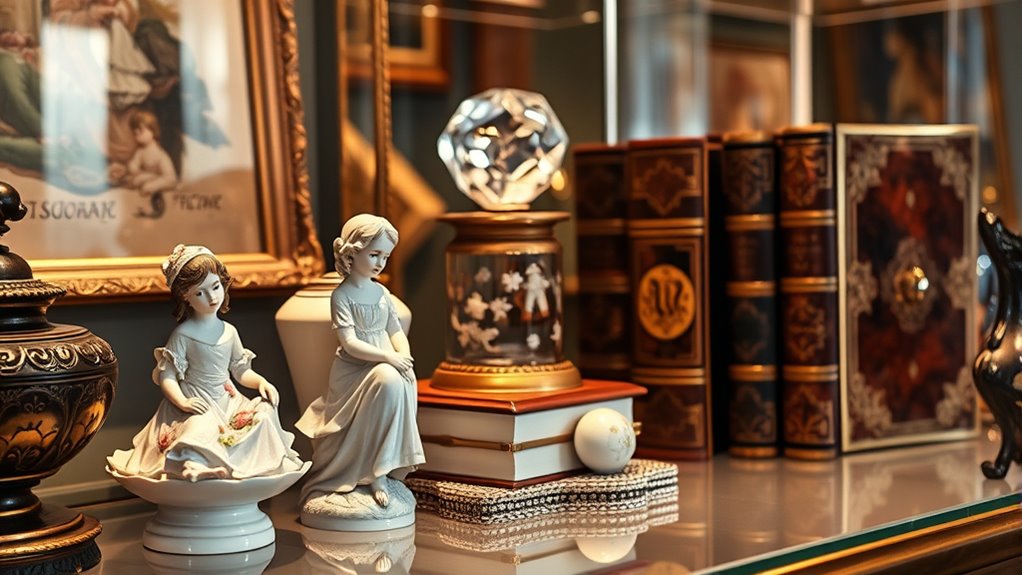
The allure of rare art lies in its exclusivity and the stories it carries. As a collector, you’re drawn to rare art because of its limited availability and compelling history. Fine art with unique features—such as signatures, provenance, or distinctive errors—stands out, boosting both its desirability and market value. Collecting these pieces isn’t just about ownership; it’s about preserving cultural significance and engaging with the art of collecting. The rarity adds a layer of prestige, making each acquisition a symbol of exclusivity. Whether historically important or simply one of a kind, rare art holds emotional and monetary appeal. Its unique features and scarcity fuel the passion for collecting, elevating it beyond mere investment to a meaningful pursuit. Additionally, understanding the story behind each piece enhances the connection between the collector and the artwork, deepening its significance. Recognizing collectible features can help collectors identify genuine rarity and value in their acquisitions. Mastering authenticity verification techniques is essential to avoid counterfeit pieces and ensure the integrity of your collection. Moreover, the wealth generated by collectibles like rare art underscores their importance as a financial asset in diversified portfolios.
Navigating the Market for Exclusive Art Pieces
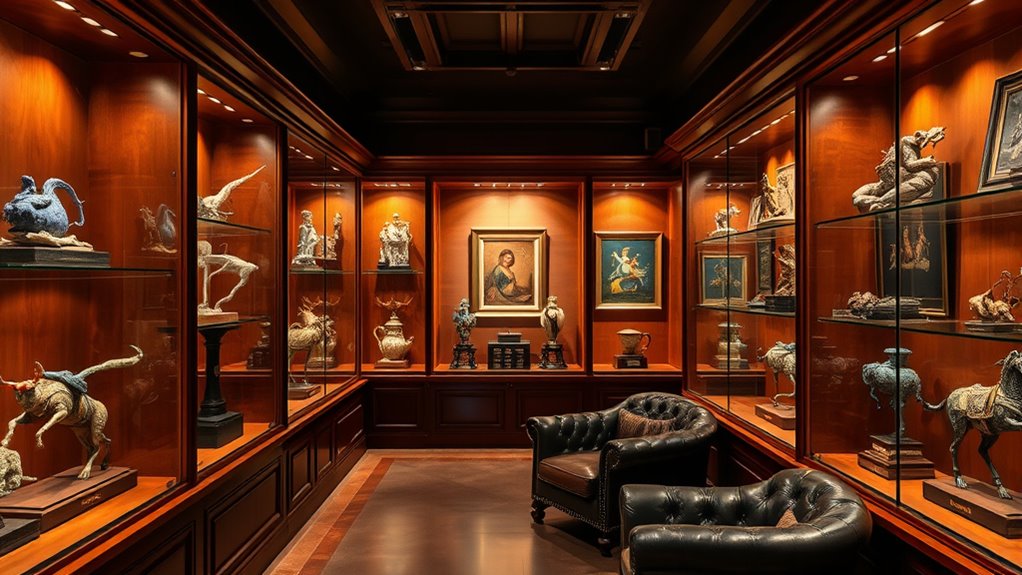
Exploring the market for exclusive art pieces requires careful research and strategic connections, as rarity and provenance heavily influence their value and appeal. To succeed, you need to stay informed about market trends and understand what makes a piece truly authentic. Verify provenance with detailed records, certificates, and expert appraisals to confirm authenticity and safeguard your investment. Reputable auction houses like Sotheby’s and Christie’s are key venues for acquiring high-value, exclusive art, offering transparency and guarantees. Limited editions, artworks from renowned periods, or by celebrated artists tend to appreciate in value over time. Building relationships with trusted art dealers, gallery owners, and fellow collectors helps you access rare pieces before they hit the broader market, ensuring your collection remains unique and highly coveted. Engaging with creative practice can also enhance your appreciation for art and deepen your understanding of artistic value and innovation. Additionally, understanding art market dynamics can give you a strategic advantage when navigating high-stakes purchases. Cultivating a mindful approach enables better discernment of true value versus fleeting trends, which is essential when considering investments in rare art that appreciate over time.
Strategies for Building a Valuable and Diverse Collection
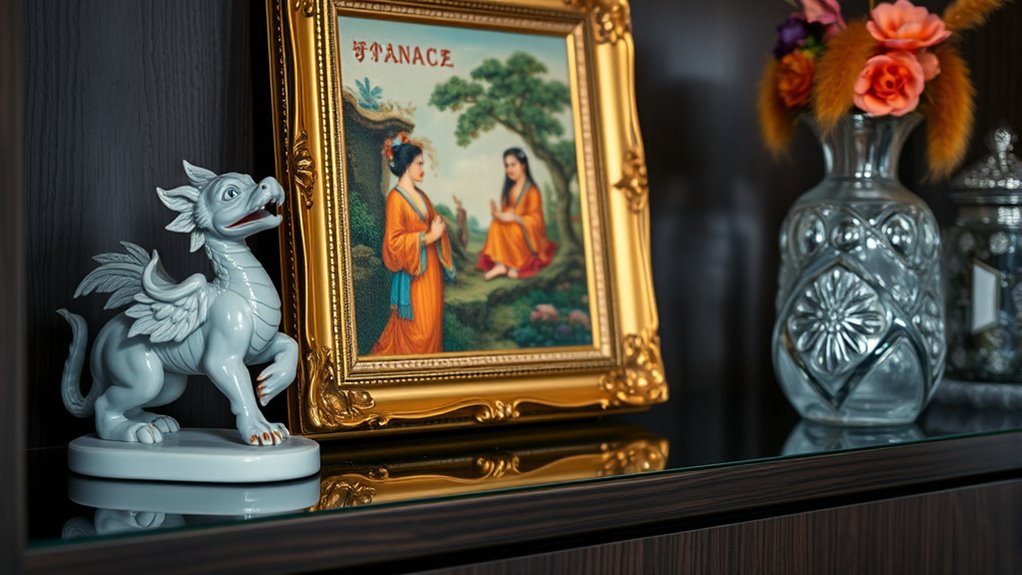
To build a valuable and diverse art collection, you should start by thoroughly researching each piece’s rarity, condition, and provenance to identify those with strong appreciation potential. Diversify your collection by including different genres, artists, and periods, which helps mitigate risk and showcases a broad spectrum of artistic expression. Networking with reputable dealers, attending art fairs, and participating in auctions can give you access to authentic artworks and exclusive opportunities. Establish a clear investment strategy and budget, focusing on pieces with strong historical significance or emerging artist potential for long-term growth. Prioritize proper preservation and documentation to maintain your collection’s authenticity and value, ensuring your art remains an attractive investment and a reflection of your diverse tastes. Incorporating unique and wicked planters into your space can also enhance the aesthetic appeal, making your collection not only valuable but visually engaging. Additionally, understanding the evolving landscape of AI in Education, such as the development of intelligent tutoring systems, can inspire innovative ways to display or interpret your collection through digital means. Recognizing the importance of emotional support can help you stay resilient and motivated during the often lengthy process of collecting rare art. Developing a strong understanding of art market trends can also guide you in making more informed purchasing decisions and timing your acquisitions effectively.
Challenges in Preserving and Maintaining Rare Artworks
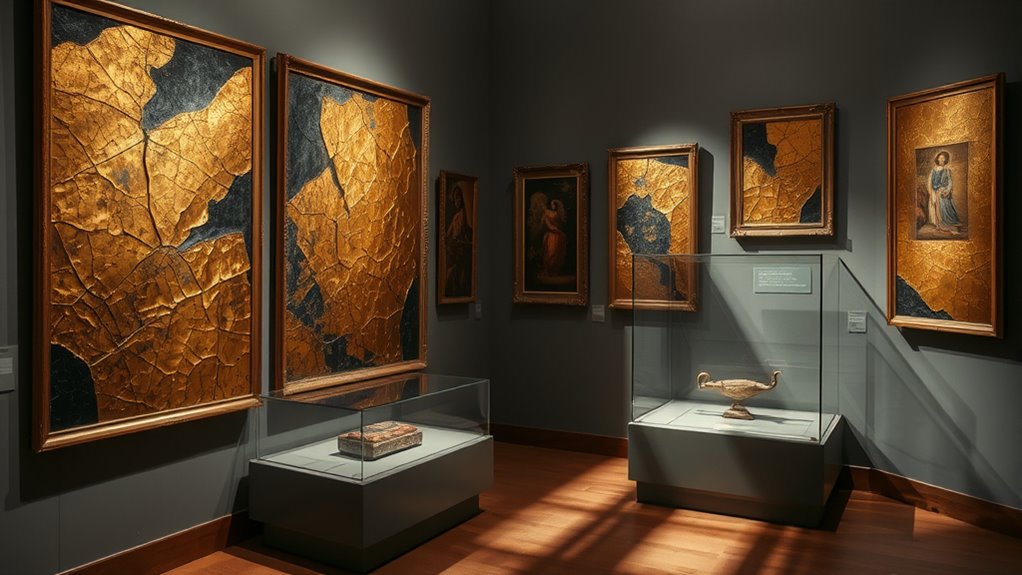
Building a diverse and valuable collection isn’t just about acquiring rare pieces; it also involves safeguarding their condition over time. Preservation requires controlling the environment—maintaining stable temperature and humidity to prevent deterioration. Regular inspections and gentle cleaning help minimize damage from dust and mold. Avoid exposure to direct sunlight and harsh lighting, as UV rays fade pigments and weaken materials. For storage, professional solutions like UV-protective glass, acid-free backing, and secure display cases are essential. Keeping detailed provenance and condition reports, along with professional conservation assessments, ensures authenticity and long-term value. Additionally, understanding environmental conditions and their impact on artworks is crucial for effective preservation, as they can significantly influence the longevity of the pieces. Staying informed about advances in art conservation techniques can further enhance preservation efforts. Proper ventilation and air quality management are also vital to prevent the buildup of harmful pollutants that can accelerate deterioration.
The Future of Collecting Rare Art and Its Investment Potential
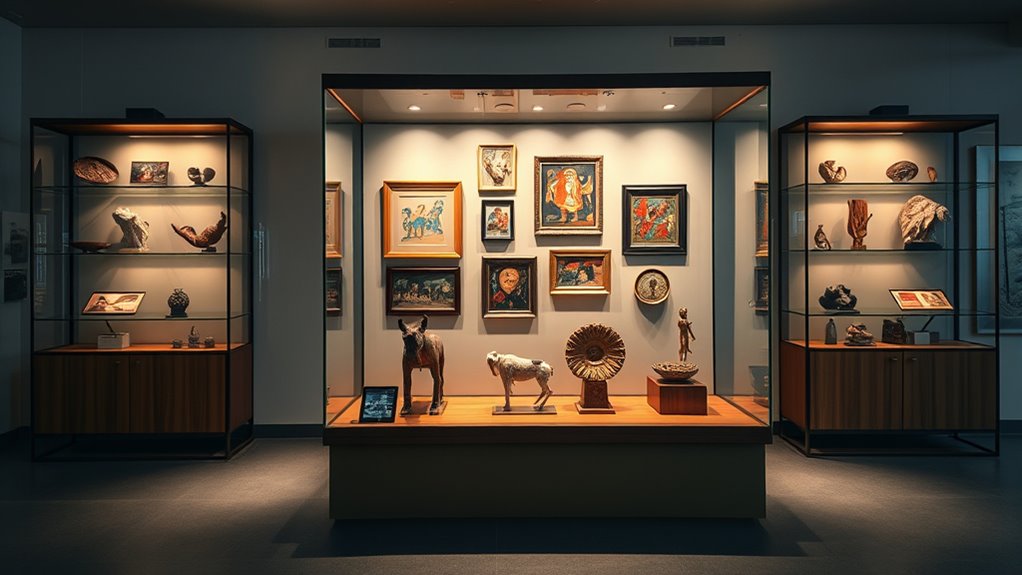
The future of collecting rare art is poised for remarkable growth, fueled by rising demand from high-net-worth individuals and expanding markets worldwide. As online marketplaces and digital auctions grow, you’ll find it easier to access and invest in art beyond traditional galleries. Provenance and historical significance remain key factors that boost an artwork’s value, making it a strong investment and a valuable asset. Market trends like digital art and NFTs are revolutionizing how you own and trade rare pieces, opening new avenues for collectors. Strategic acquisitions of emerging artists’ works can lead to substantial long-term returns, especially as global interest in cultural assets continues to grow. Additionally, understanding the importance of art valuation can help collectors make informed decisions and maximize their investments. Recognizing collecting trends allows investors to stay ahead of the curve and capitalize on shifting preferences. Staying informed about market fluctuations and economic indicators can also help optimize investment timing. An awareness of art market dynamics enables collectors to better anticipate shifts and capitalize on emerging opportunities. The evolving landscape promises exciting opportunities for those looking to combine passion with investment potential.
Frequently Asked Questions
Why Do Wealthy People Collect Art?
You collect art because it’s a powerful way to showcase your status and cultural taste. By owning rare, valuable pieces, you demonstrate your sophistication and social standing. Art also offers financial appreciation, making it a smart investment. Plus, supporting artists and preserving cultural heritage gives you a sense of purpose. Ultimately, collecting art allows you to enjoy beauty, history, and legacy all at once.
Is Art an Expensive Hobby?
You might think art is just a hobby, but it’s often an expensive one. High-profile pieces sell for millions, and even emerging artists’ works can cost thousands. Buying, insuring, maintaining, and displaying art adds up quickly. So, yes, art can be a costly pursuit, especially if you’re aiming for rare or valuable pieces. It’s not just about passion—it’s about making a significant financial investment.
Is Collecting Art a Hobby?
Yes, collecting art is definitely a hobby. You get to explore your personal tastes, discover new artists, and enjoy the emotional connection with each piece. You might start small, visiting galleries or attending art fairs, and gradually build your collection based on what moves you. Unlike investments, your focus stays on the pleasure and meaning art brings to your life, making it a deeply personal and rewarding activity.
Is Art Collecting Worth It?
You might wonder if art collecting is worth it. The answer is yes if you enjoy discovering new pieces and supporting artists. It offers cultural enrichment, personal satisfaction, and potential financial gains as artworks can appreciate over time. By doing careful research and seeking expert advice, you can make informed choices that maximize both your enjoyment and investment return, making it a truly rewarding hobby.
Conclusion
Collecting rare art is like chasing a shimmering star—you never quite catch it, but the pursuit is thrilling. With passion and strategy, you can build a collection that’s both meaningful and valuable. Stay informed, preserve your pieces carefully, and embrace the evolving market. As you navigate this luxurious hobby, remember that the true reward lies in the joy of discovering hidden treasures and making your mark in the world of art.
